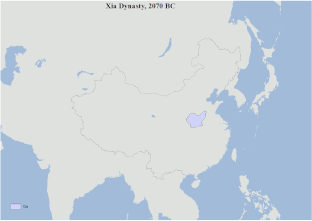 Global Information
Global InformationHistory of China information

| Part of a series on the |
| History of China |
|---|
|
The history of China spans several millennia across a wide geographical area. Each region now considered part of the Chinese world has experienced periods of unity, fracture, prosperity, and strife. Chinese civilization first emerged in the Yellow River valley, which along with the Yangtze basin constitutes the geographic core of the Chinese cultural sphere. China maintains a rich diversity of ethnic and linguistic people groups. The traditional lens for viewing Chinese history is the dynastic cycle: imperial dynasties rise and fall, and are ascribed certain achievements. Throughout pervades the narrative that Chinese civilization can be traced as an unbroken thread many thousands of years into the past, making it one of the cradles of civilization. At various times, states representative of a dominant Chinese culture have directly controlled areas stretching as far west as the Tian Shan, the Tarim Basin, and the Himalayas, as far north as the Sayan Mountains, and as far south as the delta of the Red River.
The Neolithic period saw increasingly complex polities begin to emerge along the Yellow and Yangtze rivers. The Erlitou culture in the central plains of China is sometimes identified with the Xia dynasty (3rd millennium BCE) of traditional Chinese historiography. The earliest surviving written Chinese dates to roughly 1250 BCE, consisting of divinations inscribed on oracle bones. Chinese bronze inscriptions, ritual texts dedicated to ancestors, form another large corpus of early Chinese writing. The earliest strata of received literature in Chinese include poetry, divination, and records of official speeches. China is believed to be one of a very few loci of independent invention of writing, and the earliest surviving records display an already-mature written language. The culture remembered by the earliest extant literature is that of the Zhou dynasty (c. 1046 – 256 BCE), China's Axial Age, during which the Mandate of Heaven was introduced, and foundations laid for philosophies such as Confucianism, Taoism, Legalism, and Wuxing.
China was first united under a single imperial state by Qin Shi Huang in 221 BCE. Orthography, weights, measures, and law were all standardized. Shortly thereafter, China entered its classical era with the Han dynasty (206 BCE – CE 220), marking a critical period. A term for the Chinese language is still "Han language", and the dominant Chinese ethnic group is known as Han Chinese. The Chinese empire reached some of its farthest geographical extents during this period. Confucianism was officially sanctioned and its core texts were edited into their received forms. Wealthy landholding families independent of the ancient aristocracy began to wield significant power. Han technology can be considered on par with that of the contemporaneous Roman Empire: mass production of paper aided the proliferation of written documents, and the written language of this period was employed for millennia afterwards. China became known internationally for its sericulture. When the Han imperial order finally collapsed after four centuries, China entered an equally lengthy period of disunity, during which Buddhism began to have a significant impact on Chinese culture, while Calligraphy, art, historiography, and storytelling flourished. Wealthy families in some cases became more powerful than the central government. The Yangtze River valley was incorporated into the dominant cultural sphere.
A period of unity began in 581 with the Sui dynasty, which soon gave way to the long-lived Tang dynasty (608–907), regarded as another Chinese golden age. The Tang dynasty saw flourishing developments in science, technology, poetry, economics, and geographical influence. China's first officially recognized empress, Wu Zetian, reigned during the dynasty's first century. Buddhism was adopted by Tang emperors. "Tang people" is the other common demonym for the Han ethnic group. After the Tang fractured, the Song dynasty (960–1279) saw the maximal extent of imperial Chinese cosmopolitan development. Mechanical printing was introduced, and many of the earliest surviving witnesses of certain texts are wood-block prints from this era. Song scientific advancement led the world, and the imperial examination system gave ideological structure to the political bureaucracy. Confucianism and Taoism were fully knit together in Neo-Confucianism.
Eventually, the Mongol Empire conquered all of China, establishing the Yuan dynasty in 1271. Contact with Europe began to increase during this time. Achievements under the subsequent Ming dynasty (1368–1644) include global exploration, fine porcelain, and many extant public works projects, such as those restoring the Grand Canal and Great Wall. Three of the four Classic Chinese Novels were written during the Ming. The Qing dynasty that succeeded the Ming was ruled by ethnic Manchu people. The Qianlong emperor (r. 1735–1796) commissioned a complete encyclopaedia of imperial libraries, totaling nearly a billion words. Imperial China reached its greatest territorial extent of during the Qing, but China came into increasing conflict with European powers, culminating in the Opium Wars and subsequent unequal treaties.
The 1911 Xinhai Revolution, led by Sun Yat-sen and others, created the modern Republic of China. From 1927, a costly civil war roiled between the Republican government under Chiang Kai-shek and the Chinese Red Army, and the industrialized Empire of Japan also invaded the divided country. After the Communist victory, Mao Zedong proclaimed the People's Republic of China (PRC) in 1949, with the Republic retreating to Taiwan. Both governments still claim sole legitimacy. The PRC has slowly accumulated the majority of diplomatic recognition, and Taiwan's status remains disputed. From 1966 to 1976, the Cultural Revolution in mainland China helped consolidate Mao's power towards the end of his life. After his death, the government began economic reforms under Deng Xiaoping, and became the world's fastest-growing major economy.[when?] China had been the most populous nation in the world for decades, until it was surpassed by India in 2023.